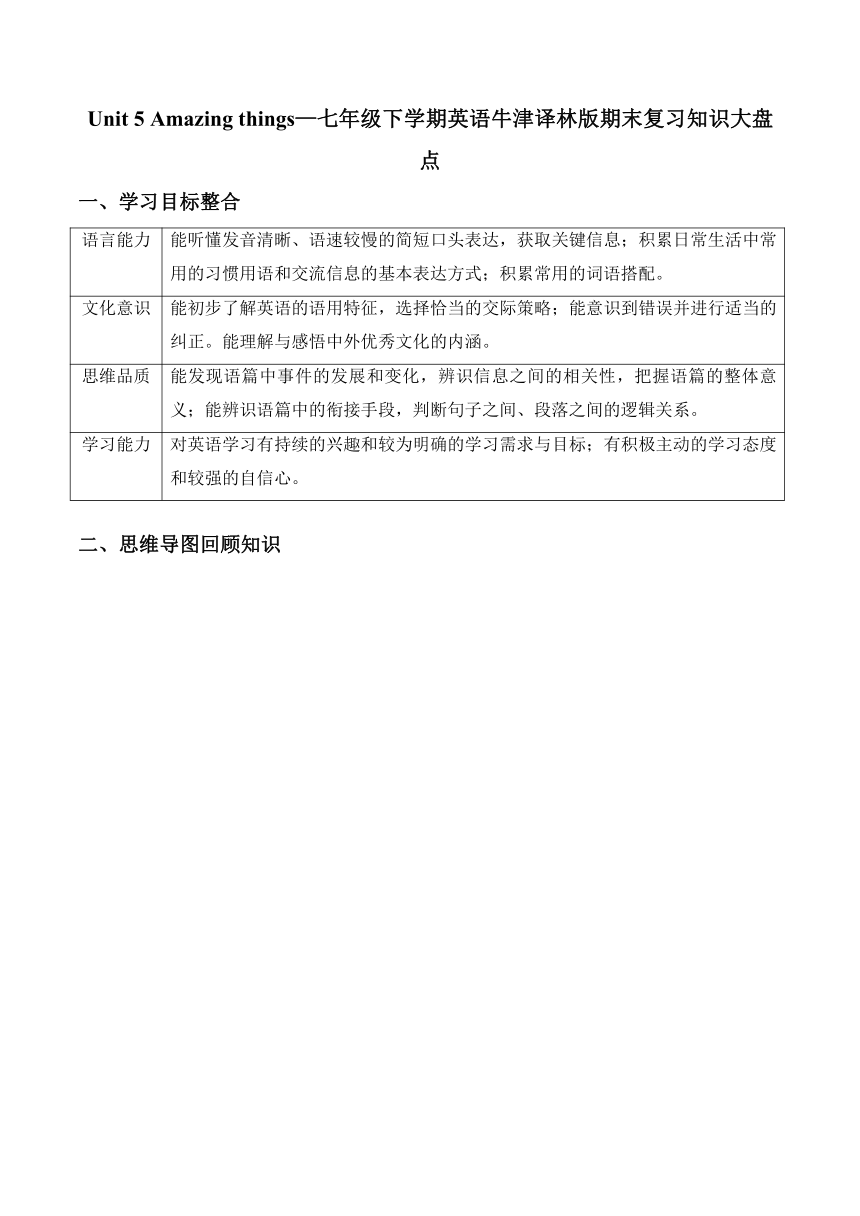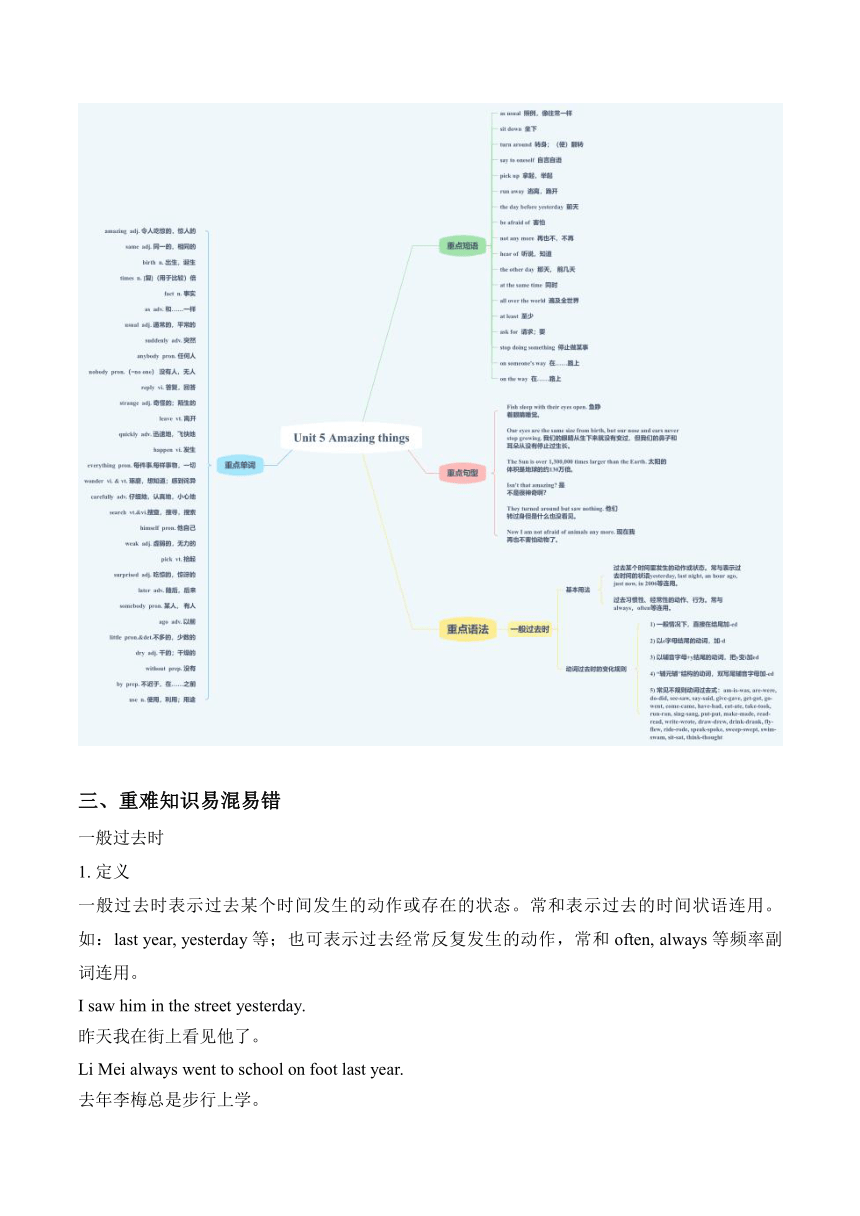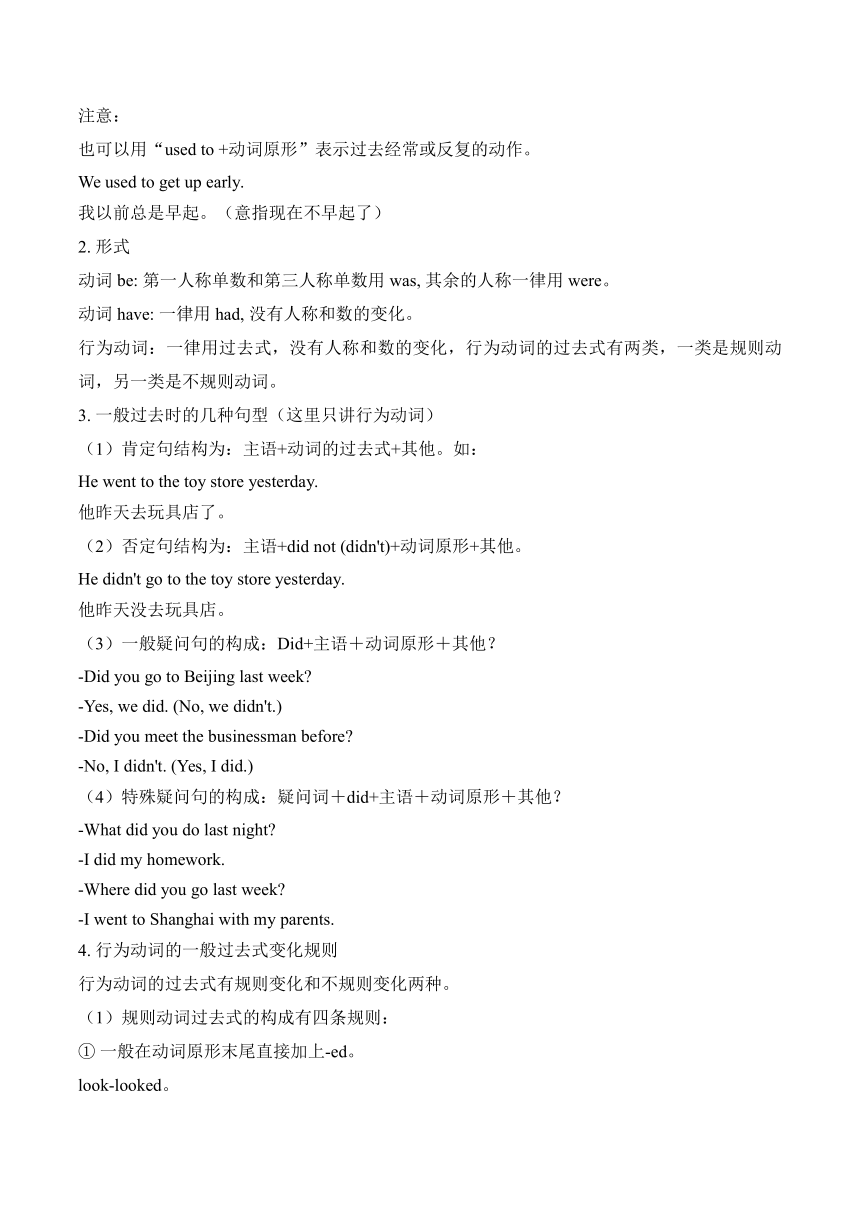Unit 5 Amazing things期末知识点复习学案 (含解析)
文档属性
| 名称 | Unit 5 Amazing things期末知识点复习学案 (含解析) |

|
|
| 格式 | docx | ||
| 文件大小 | 150.4KB | ||
| 资源类型 | 教案 | ||
| 版本资源 | 牛津译林版 | ||
| 科目 | 英语 | ||
| 更新时间 | 2024-05-27 19:50:14 | ||
图片预览




文档简介
Unit 5 Amazing things—七年级下学期英语牛津译林版期末复习知识大盘点
一、学习目标整合
语言能力 能听懂发音清晰、语速较慢的简短口头表达,获取关键信息;积累日常生活中常用的习惯用语和交流信息的基本表达方式;积累常用的词语搭配。
文化意识 能初步了解英语的语用特征,选择恰当的交际策略;能意识到错误并进行适当的纠正。能理解与感悟中外优秀文化的内涵。
思维品质 能发现语篇中事件的发展和变化,辨识信息之间的相关性,把握语篇的整体意义;能辨识语篇中的衔接手段,判断句子之间、段落之间的逻辑关系。
学习能力 对英语学习有持续的兴趣和较为明确的学习需求与目标;有积极主动的学习态度和较强的自信心。
二、思维导图回顾知识
三、重难知识易混易错
一般过去时
1. 定义
一般过去时表示过去某个时间发生的动作或存在的状态。常和表示过去的时间状语连用。如:last year, yesterday等;也可表示过去经常反复发生的动作,常和often, always等频率副词连用。
I saw him in the street yesterday.
昨天我在街上看见他了。
Li Mei always went to school on foot last year.
去年李梅总是步行上学。
注意:
也可以用“used to +动词原形”表示过去经常或反复的动作。
We used to get up early.
我以前总是早起。(意指现在不早起了)
2. 形式
动词be: 第一人称单数和第三人称单数用was, 其余的人称一律用were。
动词have: 一律用had, 没有人称和数的变化。
行为动词:一律用过去式,没有人称和数的变化,行为动词的过去式有两类,一类是规则动词,另一类是不规则动词。
3. 一般过去时的几种句型(这里只讲行为动词)
(1)肯定句结构为:主语+动词的过去式+其他。如:
He went to the toy store yesterday.
他昨天去玩具店了。
(2)否定句结构为:主语+did not (didn't)+动词原形+其他。
He didn't go to the toy store yesterday.
他昨天没去玩具店。
(3)一般疑问句的构成:Did+主语+动词原形+其他?
-Did you go to Beijing last week
-Yes, we did. (No, we didn't.)
-Did you meet the businessman before
-No, I didn't. (Yes, I did.)
(4)特殊疑问句的构成:疑问词+did+主语+动词原形+其他?
-What did you do last night
-I did my homework.
-Where did you go last week
-I went to Shanghai with my parents.
4. 行为动词的一般过去式变化规则
行为动词的过去式有规则变化和不规则变化两种。
(1)规则动词过去式的构成有四条规则:
① 一般在动词原形末尾直接加上-ed。
look-looked。
② 以不发音的字母e结尾的动词,去e再加-ed。
live-lived。
③ 末尾只有一个辅音字母的重读闭音节,先双写这个辅音字母,再加-ed。
stop-stopped。
④ 末尾是辅音字母+y结尾的动词,先变y为i,然后再加-ed。
study-studied。
(2)不规则动词的过去式需特殊记忆
am(is)-was, are-were, go-went, come-came, take-took, have (has)-had等。
练习
1.There is _____ milk in the fridge, is there
A.few B.a few C.little D.a little
2.It's very cold outside. Most of the families keep their windows _____.
A.open B.opened C.close D.closed
3.—My feelings for you have not changed.
—But you have changed. You are not as you _____.
A. are B. were C. will be D. have been
4.— Next Friday is Lucy’s birthday. Let’s ______ the birthday dinner.
— OK. How about some fruit and cakes
A. come on B. think about C. ask for D. play with
5.Today, dogs are still our best friends, they help us in ________ different ways.
A. many B. few C. much D. little
6.Don’t be so ________. For me, his failure (失败) is not ________.
A. surprising; surprising B. surprised; surprised
C. surprised; surprising D. surprising; surprised
7.Ning zetao swam ________ than any other swimmers. And he won the first prize.
A. quick B. quicker C. quickly D. more quickly
8.— People should stop ______________ the bear for their fur.
—Yes, let’s do something to help these poor bears.
A. to kill B. killing C. kills D. being killed
9.We are in ________ school, but we are in ________ grades.
A. different, the same B. the same, different
C. same, different D. the same, the different
10.—Excuse me. Is the Community Library open all day
—________. Only from 8:30 a.m. to 4:30 p.m. And it is also closed on Thursday.
A. I hope not B. Yes, of course C. That’s right D. I’m afraid not
答案
1.答案:C
解析:句意: 冰箱里几乎没有牛奶了, 汤姆, 去买些。little和a little修饰不可数名词, few和a few修饰可数名词, little和few强调少, 表示否定的含义, a little和a few强调有一些表示肯定的含义。故选C。
2.答案:D
解析:固定结构"keep+宾语+形容词", 让......保持某种状态, 根据句意, 选"关闭", 其形容词是closed。句意: 外面天气很冷。大多数家庭让窗子关着。故选D。
3.答案:B
解析:考查时态辨析。根据答语的前句句意"但是你已经变了"可知, 后句表述"你不像你以前那样", 用一般过去时。故选B。
4.答案:B
解析:句意:——下星期五是露西的生日。让我们想想生日晚餐吧。——好的。来点水果和蛋糕怎么样?考查动词短语。come on快点;think about考虑;ask for请求;play with和……玩。根据“Next Friday is Lucy’s birthday. Let’s...the birthday dinner”可知此处是指想一想生日晚餐。故选B。
5.答案:A
解析:句意:今天,狗仍然是我们最好的朋友,它们以许多不同的方式帮助我们。考查不定代词。many许多,修饰可数名词复数形式;few很少,修饰可数名词复数形式;much很多,修饰不可数名词;little不多的、少量的,修饰不可数名词。空处的词是修饰复数名词ways,故排除C、D项;根据前句“dogs are still our best friends,”可推知,应是以许多不同的方式帮助我们,故空处应用many“许多”。故选A。
6.答案:C
解析:句意:不要那么惊讶。对我来说,他的失败并不奇怪。考查形容词辨析。surprised意为“感到惊讶的”,常用来描述人;surprising意为“令人惊讶的”,常用来描述物。第一空主语是人,故用surprised;第二处修饰名词failure用surprising。故选C。
7.答案:D
解析:句意:宁泽涛比其他任何游泳运动员都游得快。而且他获得了第一名。考查比较级。swam“游泳”,是动词,需用副词quickly修饰动词,可排除A、B选项。再根据“than”可知此句应用比较级。故选D。
8.答案:B
解析:句意:——人们不应该为了熊的皮毛而杀死熊。——是的,让我们做些什么来帮助这些可怜的熊。考查非谓语动词。由答语“Yes, let’s do something to help these poor bears.”可知,此句是说停止杀死熊。stop doing sth.“停止做某事”。故选B。
9.答案:B
解析:句意:我们在同一所学校,但我们在不同的年级。考查形容词辨析。same“相同的”,前面通常要有一个定冠词the,但是如果same前有this,those等词,就不能与the连用了;different“不同的”,其后的可数名词应是复数形式。根据“We are in...school, but we are in...grades”可知第一空表示相同的学校,第二空表示不同的年级。same前要加the,different前不需要the。故选B。
10.答案:D
解析:句意:——打扰一下。社区图书馆全天开放吗?——恐怕不是。仅从上午8:30到下午4:30,周四也关门。考查情景交际。I hope not我希望不是;Yes, of course是的,当然了;That’s right那是对的;I’m afraid not恐怕不是。根据“Only from 8:30 a.m. to 4:30 p.m. And it is also closed on Thursday.”可知社区图书馆恐怕不是全天开放。故选D。
四、核心素养对接中考
一、
Nature is amazing! Take a close look at the world of insects(昆虫), and you'll discover many unbelievable things. Consider butterflies, for example. They have beautiful, colorful wings, and strong, fantastic flying skills. On summer days, you always see them flying freely over flower gardens and wild fields.
But, did you know how butterflies become the flying insects It's one of the amazing wonders of nature. In the beginning, female butterflies lay a small and colorful egg on a leaf or stem(茎) of a plant.
It's hard to believe that the egg will become something completely different in a few days. It becomes a walking insect. This insect is called the caterpillar. It now has legs, eyes and a large body. A new life has begun. The caterpillar can eat, walk and see. But it is still not a butterfly.
Soon, after growing big, the caterpillar makes a cover for itself. It covers itself in the nice protective blanket(保护层) and goes to sleep. This stage is known as the "pupa(蛹)" stage.
After a period of time, the blanket breaks and a wet, weak butterfly appears. It now has six legs, a mouth, eyes and wings. Shortly, the wings fill with blood, and the beautiful, colorful butterfly spreads its wings and flies away.
After a few weeks, this adult butterfly lays her eggs, and the cycle begins all over again.
This is just one example of the wonders of nature. Look around the natural world, and you will learn many truly amazing things.
1. What is NOT mentioned in Paragraph 1
A. Butterflies are a kind of insect. B. Butterflies are good at flying.
C. Butterflies have colorful wings. D. Butterflies have a good sense of smell.
2. What does the underlined word "caterpillar" in Paragraph 3 mean in Chinese
A.幼虫 B.雏鸟 C.飞蛾 D.蝴蝶
3. What is the right order of the development process(发育过程) of a butterfly
①It becomes a pupa.
②It becomes a walking insect.
③Female butterflies lay an egg.
④It spreads wings and flies away.
A.①→②→③→④ B.①→②→④→③ C.③→②→①→④ D.③→②→④→①
4. Which of the following best describes a butterfly after the blanket breaks
A. It has legs, eyes and a large body.
B. It has legs, eyes and a mouth.
C. It has six legs, a mouth, eyes and wings.
D. It has legs, eyes, a mouth and a large body.
5. What can be the best title for the text
A. One Insect, Different Colors B. One Insect, Four Lives
C. The Kinds of Butterflies D. The Habits of Butterflies
二、
A: Excuse me, could you tell me the way to the Rennin Park
B: Go along this street to the end. Turn left and go across a bridge, and you’ll find it on your right.
A: ①_______
B: It’s about thirty minutes’ walk.
A: ②______
B: Yes. You can take a bus.
A: ③______
B: The No. 7 bus.
A: ④_______
B: Yes. There’s a public phone on the other side of the street.
A: ⑤_______.
B: You are welcome.
答案
一、
1.答案:D
解析:细节理解题。短文第一段提到了蝴蝶是一种昆虫,有绚丽多彩的翅膀并善于飞行,没有提到它有良好的嗅觉。故选D。
2.答案:A
解析:词义猜测题。根据"It becomes a walking insect." "It now has legs, eyes and a large body."及"The caterpillar can eat, walk and see. But it is still not a butterfly."可知,它不是雏鸟、飞蛾和蝴蝶,由此猜测它应该是幼虫。故选A。
3.答案:C
解析:情节排序题。根据短文第二段至第五段可知,先是雌性蝴蝶产下卵,接着卵孵化成幼虫,幼虫变成蛹,最后由蛹蜕变成蝴蝶。故选C。
4.答案:C
解析:细节理解题。根据短文第五段中的"After a period of time, the blanket breaks and a wet, weak butterfly appears. It now has six legs, a mouth, eyes and wings."可知,保护层破开后,出来的蝴蝶有六条腿、一张嘴、眼睛和翅膀。故选C。
5.答案:B
解析:最佳标题题。通过阅读全文可知,文章主要介绍了蝴蝶一生的四次生命蜕变。故选B。
二、
答案:①How far is it from here ②Can I take a bus ③Which bus can I take/Which bus should I take ④Is there a public phone near here ⑤Thanks a lot/Thank you/Thanks(very much)
解析:本文是A、B两个人之间的对话。A项B询问去人民公园的路。
①根据“It’s about thirty minutes’ walk.”可知,此处询问距离。故填How far is it from here。
②根据“Yes. You can take a bus.”可知,此处是一般疑问句,询问对方是否可以乘坐公共汽车。故填Can I take a bus。
③根据“The No. 7 bus.”可知,此处询问我应该乘坐哪一班公交车。故填Which bus can I take/Which bus should I take。
④根据“Yes. There’s a public phone on the other side of the street.”可知,此处是一般疑问句,询问是否有公用电话。故填Is there a public phone near here。
⑤根据“You are welcome.”可知,此处表示感谢。故填Thanks a lot/Thank you/Thanks(very much)。
一、学习目标整合
语言能力 能听懂发音清晰、语速较慢的简短口头表达,获取关键信息;积累日常生活中常用的习惯用语和交流信息的基本表达方式;积累常用的词语搭配。
文化意识 能初步了解英语的语用特征,选择恰当的交际策略;能意识到错误并进行适当的纠正。能理解与感悟中外优秀文化的内涵。
思维品质 能发现语篇中事件的发展和变化,辨识信息之间的相关性,把握语篇的整体意义;能辨识语篇中的衔接手段,判断句子之间、段落之间的逻辑关系。
学习能力 对英语学习有持续的兴趣和较为明确的学习需求与目标;有积极主动的学习态度和较强的自信心。
二、思维导图回顾知识
三、重难知识易混易错
一般过去时
1. 定义
一般过去时表示过去某个时间发生的动作或存在的状态。常和表示过去的时间状语连用。如:last year, yesterday等;也可表示过去经常反复发生的动作,常和often, always等频率副词连用。
I saw him in the street yesterday.
昨天我在街上看见他了。
Li Mei always went to school on foot last year.
去年李梅总是步行上学。
注意:
也可以用“used to +动词原形”表示过去经常或反复的动作。
We used to get up early.
我以前总是早起。(意指现在不早起了)
2. 形式
动词be: 第一人称单数和第三人称单数用was, 其余的人称一律用were。
动词have: 一律用had, 没有人称和数的变化。
行为动词:一律用过去式,没有人称和数的变化,行为动词的过去式有两类,一类是规则动词,另一类是不规则动词。
3. 一般过去时的几种句型(这里只讲行为动词)
(1)肯定句结构为:主语+动词的过去式+其他。如:
He went to the toy store yesterday.
他昨天去玩具店了。
(2)否定句结构为:主语+did not (didn't)+动词原形+其他。
He didn't go to the toy store yesterday.
他昨天没去玩具店。
(3)一般疑问句的构成:Did+主语+动词原形+其他?
-Did you go to Beijing last week
-Yes, we did. (No, we didn't.)
-Did you meet the businessman before
-No, I didn't. (Yes, I did.)
(4)特殊疑问句的构成:疑问词+did+主语+动词原形+其他?
-What did you do last night
-I did my homework.
-Where did you go last week
-I went to Shanghai with my parents.
4. 行为动词的一般过去式变化规则
行为动词的过去式有规则变化和不规则变化两种。
(1)规则动词过去式的构成有四条规则:
① 一般在动词原形末尾直接加上-ed。
look-looked。
② 以不发音的字母e结尾的动词,去e再加-ed。
live-lived。
③ 末尾只有一个辅音字母的重读闭音节,先双写这个辅音字母,再加-ed。
stop-stopped。
④ 末尾是辅音字母+y结尾的动词,先变y为i,然后再加-ed。
study-studied。
(2)不规则动词的过去式需特殊记忆
am(is)-was, are-were, go-went, come-came, take-took, have (has)-had等。
练习
1.There is _____ milk in the fridge, is there
A.few B.a few C.little D.a little
2.It's very cold outside. Most of the families keep their windows _____.
A.open B.opened C.close D.closed
3.—My feelings for you have not changed.
—But you have changed. You are not as you _____.
A. are B. were C. will be D. have been
4.— Next Friday is Lucy’s birthday. Let’s ______ the birthday dinner.
— OK. How about some fruit and cakes
A. come on B. think about C. ask for D. play with
5.Today, dogs are still our best friends, they help us in ________ different ways.
A. many B. few C. much D. little
6.Don’t be so ________. For me, his failure (失败) is not ________.
A. surprising; surprising B. surprised; surprised
C. surprised; surprising D. surprising; surprised
7.Ning zetao swam ________ than any other swimmers. And he won the first prize.
A. quick B. quicker C. quickly D. more quickly
8.— People should stop ______________ the bear for their fur.
—Yes, let’s do something to help these poor bears.
A. to kill B. killing C. kills D. being killed
9.We are in ________ school, but we are in ________ grades.
A. different, the same B. the same, different
C. same, different D. the same, the different
10.—Excuse me. Is the Community Library open all day
—________. Only from 8:30 a.m. to 4:30 p.m. And it is also closed on Thursday.
A. I hope not B. Yes, of course C. That’s right D. I’m afraid not
答案
1.答案:C
解析:句意: 冰箱里几乎没有牛奶了, 汤姆, 去买些。little和a little修饰不可数名词, few和a few修饰可数名词, little和few强调少, 表示否定的含义, a little和a few强调有一些表示肯定的含义。故选C。
2.答案:D
解析:固定结构"keep+宾语+形容词", 让......保持某种状态, 根据句意, 选"关闭", 其形容词是closed。句意: 外面天气很冷。大多数家庭让窗子关着。故选D。
3.答案:B
解析:考查时态辨析。根据答语的前句句意"但是你已经变了"可知, 后句表述"你不像你以前那样", 用一般过去时。故选B。
4.答案:B
解析:句意:——下星期五是露西的生日。让我们想想生日晚餐吧。——好的。来点水果和蛋糕怎么样?考查动词短语。come on快点;think about考虑;ask for请求;play with和……玩。根据“Next Friday is Lucy’s birthday. Let’s...the birthday dinner”可知此处是指想一想生日晚餐。故选B。
5.答案:A
解析:句意:今天,狗仍然是我们最好的朋友,它们以许多不同的方式帮助我们。考查不定代词。many许多,修饰可数名词复数形式;few很少,修饰可数名词复数形式;much很多,修饰不可数名词;little不多的、少量的,修饰不可数名词。空处的词是修饰复数名词ways,故排除C、D项;根据前句“dogs are still our best friends,”可推知,应是以许多不同的方式帮助我们,故空处应用many“许多”。故选A。
6.答案:C
解析:句意:不要那么惊讶。对我来说,他的失败并不奇怪。考查形容词辨析。surprised意为“感到惊讶的”,常用来描述人;surprising意为“令人惊讶的”,常用来描述物。第一空主语是人,故用surprised;第二处修饰名词failure用surprising。故选C。
7.答案:D
解析:句意:宁泽涛比其他任何游泳运动员都游得快。而且他获得了第一名。考查比较级。swam“游泳”,是动词,需用副词quickly修饰动词,可排除A、B选项。再根据“than”可知此句应用比较级。故选D。
8.答案:B
解析:句意:——人们不应该为了熊的皮毛而杀死熊。——是的,让我们做些什么来帮助这些可怜的熊。考查非谓语动词。由答语“Yes, let’s do something to help these poor bears.”可知,此句是说停止杀死熊。stop doing sth.“停止做某事”。故选B。
9.答案:B
解析:句意:我们在同一所学校,但我们在不同的年级。考查形容词辨析。same“相同的”,前面通常要有一个定冠词the,但是如果same前有this,those等词,就不能与the连用了;different“不同的”,其后的可数名词应是复数形式。根据“We are in...school, but we are in...grades”可知第一空表示相同的学校,第二空表示不同的年级。same前要加the,different前不需要the。故选B。
10.答案:D
解析:句意:——打扰一下。社区图书馆全天开放吗?——恐怕不是。仅从上午8:30到下午4:30,周四也关门。考查情景交际。I hope not我希望不是;Yes, of course是的,当然了;That’s right那是对的;I’m afraid not恐怕不是。根据“Only from 8:30 a.m. to 4:30 p.m. And it is also closed on Thursday.”可知社区图书馆恐怕不是全天开放。故选D。
四、核心素养对接中考
一、
Nature is amazing! Take a close look at the world of insects(昆虫), and you'll discover many unbelievable things. Consider butterflies, for example. They have beautiful, colorful wings, and strong, fantastic flying skills. On summer days, you always see them flying freely over flower gardens and wild fields.
But, did you know how butterflies become the flying insects It's one of the amazing wonders of nature. In the beginning, female butterflies lay a small and colorful egg on a leaf or stem(茎) of a plant.
It's hard to believe that the egg will become something completely different in a few days. It becomes a walking insect. This insect is called the caterpillar. It now has legs, eyes and a large body. A new life has begun. The caterpillar can eat, walk and see. But it is still not a butterfly.
Soon, after growing big, the caterpillar makes a cover for itself. It covers itself in the nice protective blanket(保护层) and goes to sleep. This stage is known as the "pupa(蛹)" stage.
After a period of time, the blanket breaks and a wet, weak butterfly appears. It now has six legs, a mouth, eyes and wings. Shortly, the wings fill with blood, and the beautiful, colorful butterfly spreads its wings and flies away.
After a few weeks, this adult butterfly lays her eggs, and the cycle begins all over again.
This is just one example of the wonders of nature. Look around the natural world, and you will learn many truly amazing things.
1. What is NOT mentioned in Paragraph 1
A. Butterflies are a kind of insect. B. Butterflies are good at flying.
C. Butterflies have colorful wings. D. Butterflies have a good sense of smell.
2. What does the underlined word "caterpillar" in Paragraph 3 mean in Chinese
A.幼虫 B.雏鸟 C.飞蛾 D.蝴蝶
3. What is the right order of the development process(发育过程) of a butterfly
①It becomes a pupa.
②It becomes a walking insect.
③Female butterflies lay an egg.
④It spreads wings and flies away.
A.①→②→③→④ B.①→②→④→③ C.③→②→①→④ D.③→②→④→①
4. Which of the following best describes a butterfly after the blanket breaks
A. It has legs, eyes and a large body.
B. It has legs, eyes and a mouth.
C. It has six legs, a mouth, eyes and wings.
D. It has legs, eyes, a mouth and a large body.
5. What can be the best title for the text
A. One Insect, Different Colors B. One Insect, Four Lives
C. The Kinds of Butterflies D. The Habits of Butterflies
二、
A: Excuse me, could you tell me the way to the Rennin Park
B: Go along this street to the end. Turn left and go across a bridge, and you’ll find it on your right.
A: ①_______
B: It’s about thirty minutes’ walk.
A: ②______
B: Yes. You can take a bus.
A: ③______
B: The No. 7 bus.
A: ④_______
B: Yes. There’s a public phone on the other side of the street.
A: ⑤_______.
B: You are welcome.
答案
一、
1.答案:D
解析:细节理解题。短文第一段提到了蝴蝶是一种昆虫,有绚丽多彩的翅膀并善于飞行,没有提到它有良好的嗅觉。故选D。
2.答案:A
解析:词义猜测题。根据"It becomes a walking insect." "It now has legs, eyes and a large body."及"The caterpillar can eat, walk and see. But it is still not a butterfly."可知,它不是雏鸟、飞蛾和蝴蝶,由此猜测它应该是幼虫。故选A。
3.答案:C
解析:情节排序题。根据短文第二段至第五段可知,先是雌性蝴蝶产下卵,接着卵孵化成幼虫,幼虫变成蛹,最后由蛹蜕变成蝴蝶。故选C。
4.答案:C
解析:细节理解题。根据短文第五段中的"After a period of time, the blanket breaks and a wet, weak butterfly appears. It now has six legs, a mouth, eyes and wings."可知,保护层破开后,出来的蝴蝶有六条腿、一张嘴、眼睛和翅膀。故选C。
5.答案:B
解析:最佳标题题。通过阅读全文可知,文章主要介绍了蝴蝶一生的四次生命蜕变。故选B。
二、
答案:①How far is it from here ②Can I take a bus ③Which bus can I take/Which bus should I take ④Is there a public phone near here ⑤Thanks a lot/Thank you/Thanks(very much)
解析:本文是A、B两个人之间的对话。A项B询问去人民公园的路。
①根据“It’s about thirty minutes’ walk.”可知,此处询问距离。故填How far is it from here。
②根据“Yes. You can take a bus.”可知,此处是一般疑问句,询问对方是否可以乘坐公共汽车。故填Can I take a bus。
③根据“The No. 7 bus.”可知,此处询问我应该乘坐哪一班公交车。故填Which bus can I take/Which bus should I take。
④根据“Yes. There’s a public phone on the other side of the street.”可知,此处是一般疑问句,询问是否有公用电话。故填Is there a public phone near here。
⑤根据“You are welcome.”可知,此处表示感谢。故填Thanks a lot/Thank you/Thanks(very much)。
